OKRs: The Complete Guide
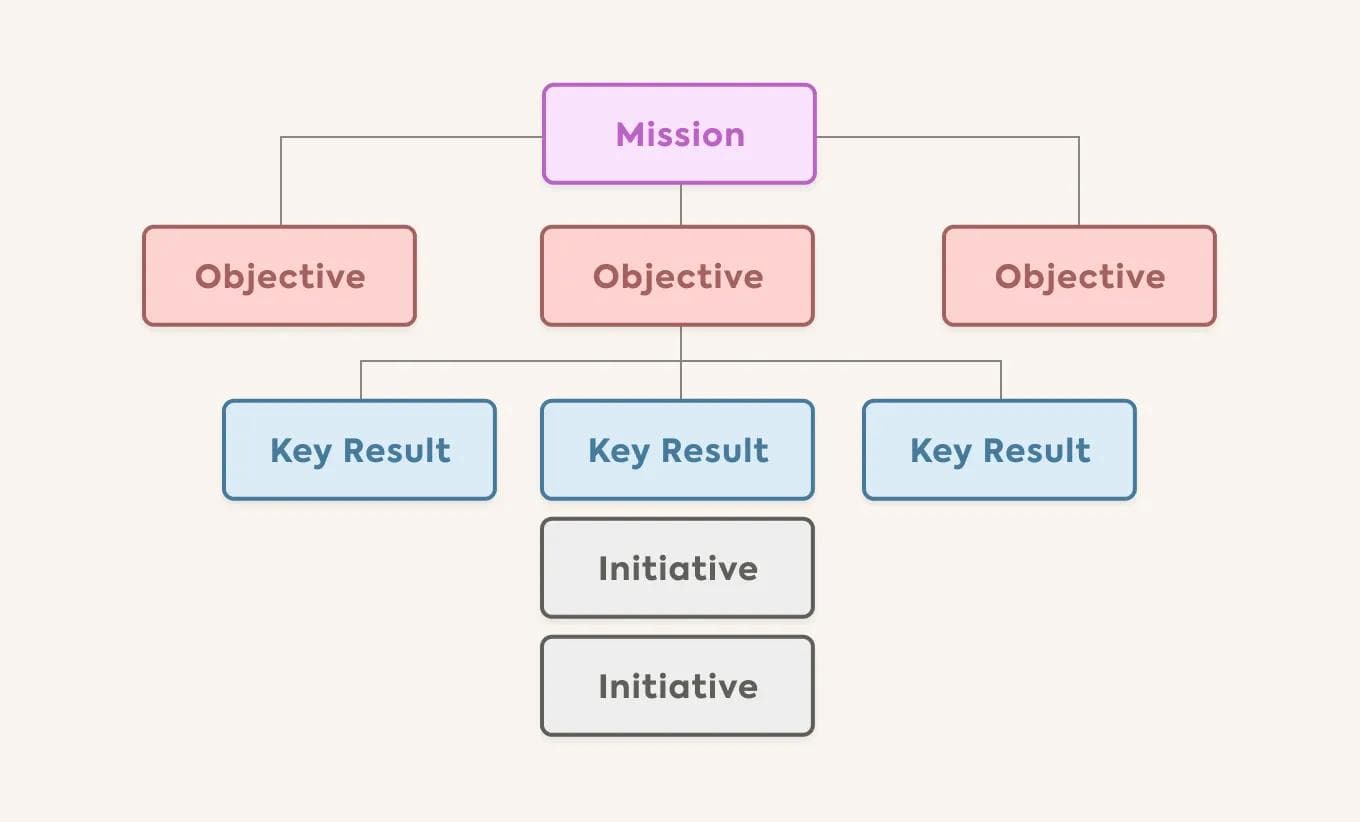
OKR (Objectives and Key Results) is an agile framework for setting goals in companies. Used correctly, the OKR method can lead to more transparency, alignment, focus and agility in your organization.
This OKR guide is divided into three parts. Readers who are already familiar with the basics can safely skip part 1 and proceed directly with part 2.
- Theory – OKR Definition, History, and Benefits
- Application – OKR Framework and Process
- Resources – FAQ, Books, and PDF download
OKR Definition: What is OKR?
The abbreviation OKR (or OKRs) stands for “Objectives and Key Results”.
This sentence describes the three characteristics of Objectives and Key Results:
- OKR as a framework: OKR offers a standardized syntax for formulating qualitative Objectives and quantitative Key Results, which combined measure whether an Objective has been achieved. OKR is therefore an instrument that considerably simplifies communication within the company.
- OKR as a strategic link: OKRs link the vision and mission of the company with the operational business. Bridging this gap is particularly important as it promotes a sense of meaningful work (purpose) among all employees.
- OKR as an agile process: OKR is a continuous process that drives Organizational Learning and agility throughout the entire company.
The interplay of these characteristics makes the OKR method a powerful tool for modern performance management and at the same time explains the rapidly growing popularity of OKRs in organizations of all sizes and industries.
Why is the OKR method so popular?

The figure above shows the worldwide development of the popularity of the search term "OKR" on Google Trends from 2004 to 2023. Especially since the beginning of 2019, a significant increase can be seen. Due to the Corona pandemic and the resulting trend towards more home office as well as initiatives for digital and agile transformation, it can be expected that the OKR method will become the new standard for performance management in companies. The first indications of this are already emerging.
The rise of OKRs: MBOs, Intel, John Doerr, and Google
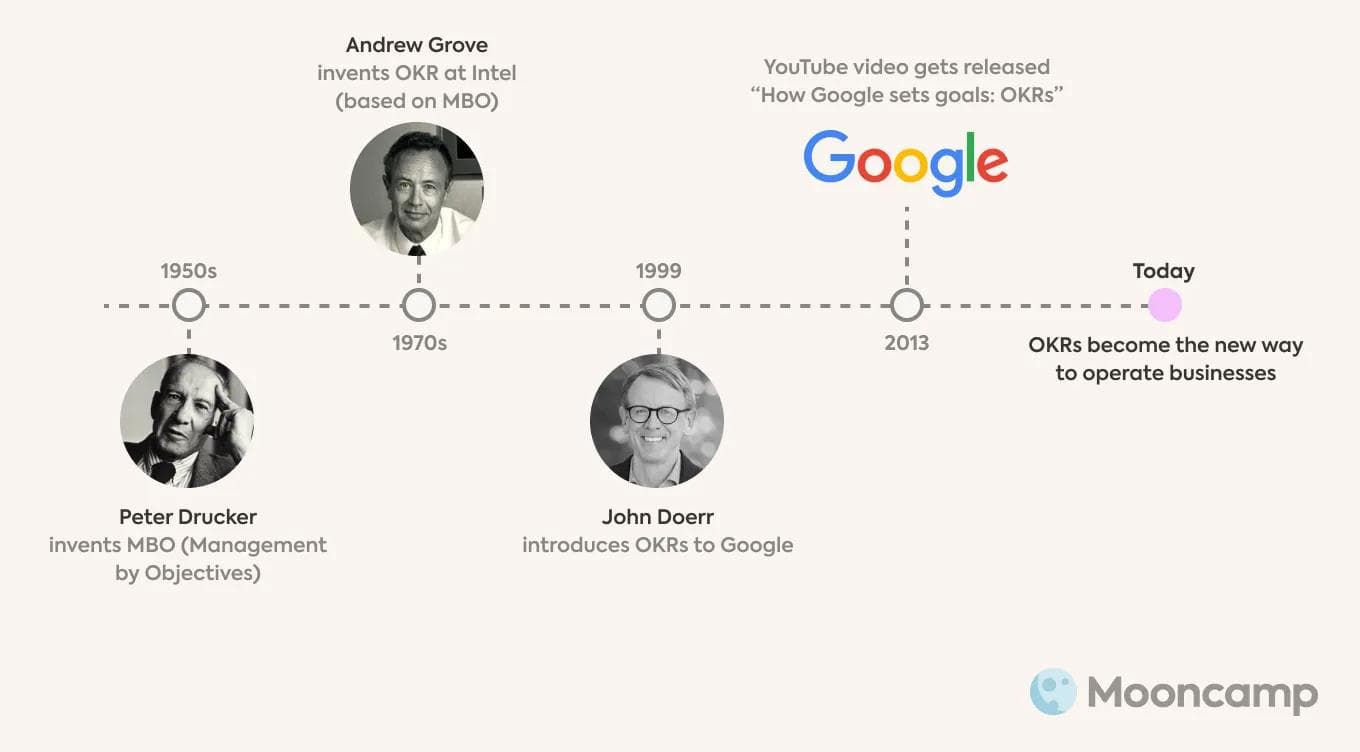
OKRs originated in the 1950s in Peter Drucker's management method Management by Objectives (MBO).
Andy Grove, third employee and later CEO of microchip manufacturer Intel, developed the OKR method based on MBOs in the 1970s and introduced it at Intel.
John Doerr, former employee at Intel, was impressed with the effectiveness of the agile goal setting method and, after joining Kleiner Perkins (one of Google's early major investors), introduced it to Google as a consultant to Larry Page and Sergey Brin.
With the help of OKRs, Google has grown from 40 to over 100,000 employees.
Google is also the reason why the OKR method has become so popular and is used by fast-growing start-ups such as Spotify or Netflix, as well as large corporations like Samsung or Volkswagen.

OKRs at Google
While Google may be the cause for the spread of the OKR model, the increasing popularity indicated in the chart is the result of another factor:
The OKR method works. OKRs are not just hype. Companies don't just want to blindly follow Google, but make the OKR framework their own, recognizing the positive effects on employee motivation and company success.
How exactly the OKR method works and how OKRs are built is explained in part 2 of this guide.
What are the benefits of OKRs?
Introducing OKRs has a number of benefits for companies:
- OKRs provide focus and alignment.
- Strategies are translated into measurable, easily understandable goals. This makes them tangible and measurable. Progress can be evaluated in concrete terms.
- OKRs promote autonomy and a sense of responsibility.
- With OKRs, companies can react more easily and quickly to changes - both operationally and strategically.
- Transparency and communication are promoted. Overall, OKRs - if used correctly - are one of the most powerful tools for creating positive change and making a company more successful in the long term. You can find out exactly how the target system works and how OKRs are structured in part 2 of the guide.
1. OKR as a framework
Objectives and Key Results
The power of the OKR framework results from the complementary concepts Objective and Key Result:
Objective | Key Result |
|---|---|
What do I want to achieve | How do I know that the goal is reached? |
Characteristics
| Characteristics
|
In addition to OKRs, companies also use so-called initiatives or key actions. These are specific actions that are derived from the OKRs.
Initiative |
|---|
How do I reach the goal? |
Characteristics
|
The following is an example that illustrates the interplay between Objective, Key Result, and initiative:
OKR example
A good example of OKRs is the transportation company Uber:
Objective
- Increase the geographical coverage of drivers
Key Results
- Increase San Francisco coverage to 100%
- Increase coverage of all active cities to 75%
- Reduce pickup time to < 10 minutes in each area during peak hours
Initiatives
- Publish new vacancies for drivers in all active cities
- Start offline marketing campaign for advertising posters near cab stands
Another popular example comes from a Google team that worked on the Chrome browser:
Objective
- Build the best web browser in the world
Key Results
- 20 million weekly active users by the end of 2008
Initiatives
- Develop a Mac version of Chrome
Characteristics of the OKR framework
OKRs are agile
Annual target agreements bear the risk of running in the wrong direction for an entire year. Instead, the OKR model has much shorter cycles. Usually, an OKR cycle is one quarter long, but 4-month or 2-month cycles can also be used. It all depends on how your organization or your teams "tick".
The OKR process is simple
The OKR method itself is easy to understand, so several OKR plannings per year are possible without being too distracting. However, setting up the OKRs is a very difficult task, since out of all the possible goals, only the truly essential ones have to be picked out during the planning processes and formulated accordingly.
OKRs are set top-down and bottom-up
In contrast to the classic top-down approach to setting goals (as is the case with MBOs, for example), OKRs are developed by both the leadership and the individual teams. Typically, 40% of OKRs are first developed by the leadership (top-down) and then 60% of OKRs are developed by the teams (bottom-up). These OKRs are then aligned with the company's Objectives.
OKRs do not have to be achieved 100%
Google and many others set OKRs as so-called "stretch goals", i.e. ambitious goals that are supposed to lead to getting out of the mindset to become 10% better but instead aim to be 10 times as good as before. The new 10X Mindset often leads to completely new approaches. This practice has shown that it is no longer important to reach 100% because even with 70% you can achieve amazing results with ambitious goals.
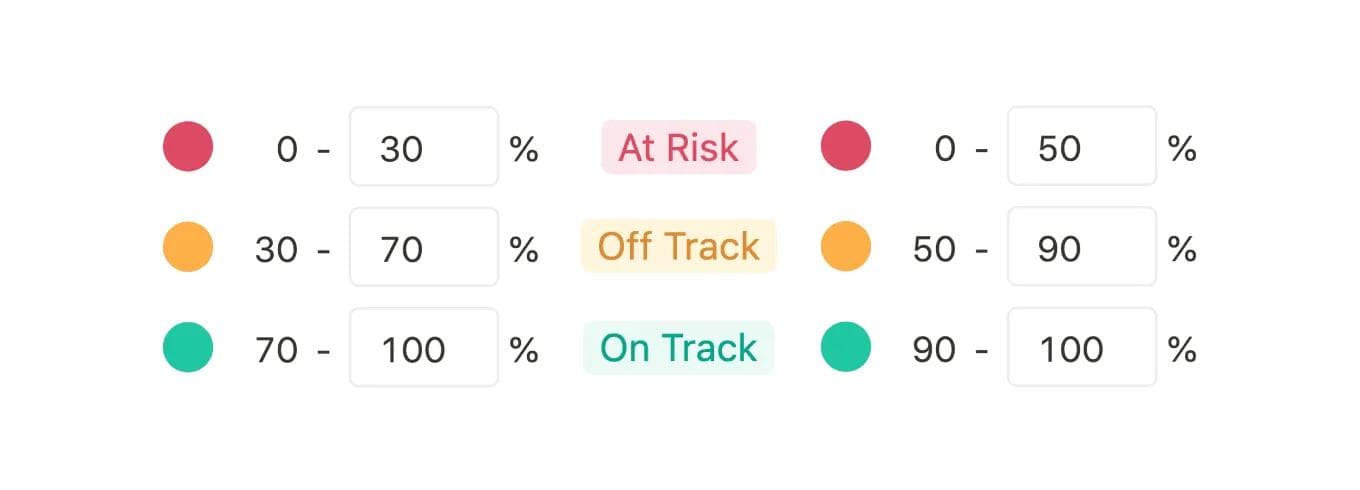
Common mistakes when implementing the OKR method
🚫 OKRs only cascade from top to bottom
Many companies make the mistake that the leadership simply passes on their goals from top to bottom. Middle management does the same as leadership and passes its goals on to team leaders, who in turn pass them on to their team members. However, this waterfall model is not in the spirit of agility, let alone the OKR method. The planning of OKRs should be done both top-down and bottom-up. This has several advantages:
- Teams become more self-organized (motivation through autonomy and involvement)
- Teams align themselves with OKRs of higher levels (vertical alignment)
- Teams see how their OKRs contribute to company goals
- Teams coordinate with other teams on the same level (horizontal alignment)
🚫 OKRs are used as a tool for performance evaluation
This is one of the most common misunderstandings in the context of OKRs: The OKR method is often misused as a performance assessment tool. Unfortunately, as soon as the compensation of employees is linked to OKRs, there is an incentive for sandbagging or under-promising. In other words, employees set themselves artificially low goals to achieve them in any case. This undermines the entire OKR framework with all its advantages.
🚫 "Business-as-usual" goals as OKRs
These "day-to-day business" OKRs are not ambitious and only reflect the status quo or normal business activities. However, OKRs should always have a growth-oriented nature.
🚫 Key Results as to-do lists
Key Results are often formulated as mere activities or as to-do's that can be checked off - this is also referred to as output-driven. However, with OKRs we want to achieve actual, success-relevant results. Key Results should, therefore, as the name suggests, be outcome-driven. The examples above illustrate the difference already very well.
It can be difficult to set up Key Results for some Objectives since the most important and most prominent key figures cannot be influenced directly and the actions taken in the current quarter may not have an impact on the key figures until the next quarter or the one after that. Metrics that cannot be directly influenced are referred to as lag measures. On the other hand, there are lead measures, i.e., metrics that can be directly influenced and whose progress can be measured immediately or only after a short delay.
The trick is to find a metric on the spectrum of lag measures and lead measures, whose progress can be directly measured and influenced, but at the same time has a strong enough connection to the relevant lag measure (e.g. revenue).
Here's an example of how to select a lead measure for a Key Result of a software sales team:
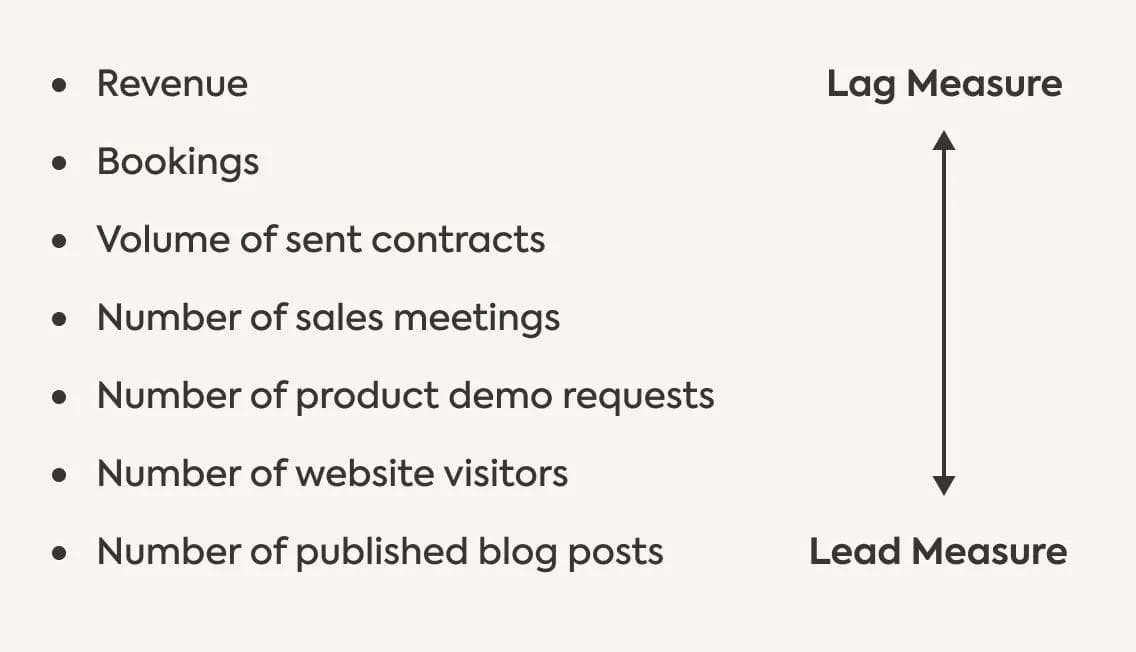
Revenue is actually the most interesting and important metric, but the number of product demo requests is probably the more suitable lead measure here, as it is still closely linked to the lag measure, but can be influenced much more easily in the short term. The number of published blog articles, on the other hand, is too far away from the relevant lag measure and measures an output (activity) rather than an outcome.
💡 Tip: when it comes to OKR implementation, there are a few more pitfalls. We have summarized the 11 most common OKR mistakes on our blog – including practical tips on how to avoid them.
2. OKR as a strategic link
OKR is more than "just" a framework for setting goals. As a management method, OKRs finally build the much-needed bridge between the vision and mission of an organization and the operational level. By linking daily tasks, which in turn are linked to agile quarterly goals and annual or multi-year goals above them, clarity and transparency are promoted throughout the company.
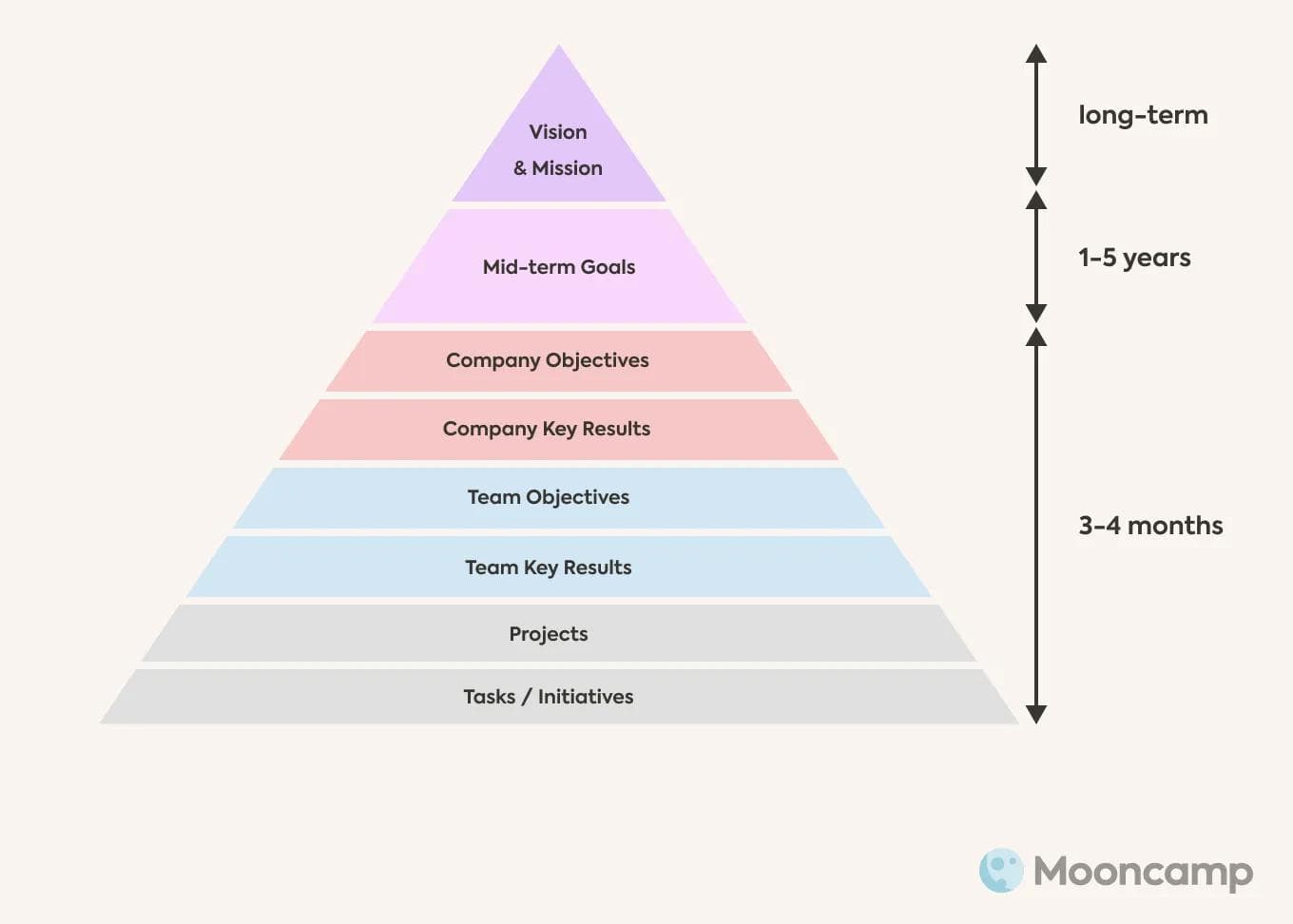
Vision and mission
Vision and mission are the strategic guidelines of the organization. They are usually defined by the leadership, set the long-term direction of the company, and should have a motivating character. These long-term goals also provide the scope for all underlying mid-term and short-term goals (OKRs).
Mid-term goals (1-5 years)
Mid-term goals usually have a time horizon of one to five years. They are more tangible than the vision and form the foundation from which the OKRs are derived. Mid-term goals are also most often developed by leadership. The OKR method can already add a lot of value here, e.g. in the formulation of goals.
The flexibility of the OKR framework also allows companies to draw up annual OKRs, for example, from which the quarterly OKRs are then derived.
OKRs at the company and team level (3-4 months)
With mid-term goals (or annual Objectives) as an anchor point, the OKR method is used to define goals at the company and team level. As described above, about 40% of the goals are set at the leadership level and 60% at the team level, thus ensuring vertical and horizontal alignment. The teams (not only the team leaders) must therefore organize themselves and define their own OKRs, which they then align with the company goals.
Below the OKRs are the project management layer and the initiatives. Many of Mooncamp's customers link their projects, tasks, or initiatives directly to the respective Objectives and Key Results.
OKRs are thus the strategic link between strategy (vision, mission, and mid-term goals) and operations (tasks, activities, and projects).
💡 Tip: You can find out more about strategy implementation on our blog. In it, we explain how to successfully implement strategies and which mistakes you should avoid.
3. OKR as method and agile process

The OKR process consists of five essential elements:
- OKR cycle
- OKR planning session
- OKR Weekly
- OKR Review
- OKR Retrospective
For a successful implementation of the OKR process and the adoption of the mindset, it is also helpful to have access to the following resources:
- OKR coach (within the company)
- Tool for OKRs (either free apps or a dedicated OKR Software)
- External OKR consultancy (if needed)
While the framework of OKR sets the rules, the agile process breathes life into the OKR model and enables all the benefits of using the framework. Each of the interactive events OKR planning session, OKR Weekly, OKR Review, and Retrospective leads to the gradual development of the agile mindset among employees. While the first OKR cycle may still seem chaotic and teams still need to find their bearings, OKRs begin to bear more and more fruit over time. This is reflected in increased transparency, more motivation through self-organization and autonomy, as well as better alignment between the teams and hierarchy levels.
OKR cycle
The OKR cycle itself determines the "pace" of the OKR method and the time period within which the OKRs are set. It also includes individual events (Planning, Weekly, Review, Retro), as shown in the figure above. In most cases, companies choose quarters or, more rarely, tertials (4 months) as the time span for a cycle. Alternating 2-month and 4-month cycles are also conceivable so that the events do not collide with other important company events or vacation periods.
OKR Planning
The OKR planning takes place before each OKR cycle. This is where both the leadership level and the teams plan their OKRs for the next iteration. The planning takes an average of around four hours for each team. In the first cycle, the duration of the planning is probably a bit longer. In the following cycles, the teams become more familiar with the OKR method so that the planning can only take two to three hours.
Before the teams start working on their OKRs, the leadership prepares the OKRs for the cycle at the company level in an OKR Planning, which are derived from the mid-term goals.
With the company OKRs as a guideline, the teams now begin to work on their OKRs independently in their own OKR planning sessions. The alignment with the company goals and the horizontal alignment with other teams ensures that the team OKRs contribute to the goals from higher levels, that no duplication of work occurs in the coming cycle, that no conflicting Key Results are set, and that potential dependencies between teams are revealed.
Here's another crazy thought: Depending on the degree of agility of the organization, at some point – based on the priorities for the respective cycle – completely new teams could be dynamically formed!
OKR Weekly
The OKR Check-in (or OKR Weekly) is a weekly team meeting where the following questions are answered:
- What is being worked on?
- What is the status of our Key Results?
- Are there any obstacles or dependencies that are blocking the work?
It serves the weekly coordination within the team and indirectly also the consolidation of the OKR framework within the company.
OKR Review
At the end of each cycle, the OKR Review takes place, in which each team (including the leadership team) presents the final status of the OKRs. Depending on the size and location of the company, the OKR Reviews can be organized as an on-site event or held virtually. In the interest of transparency and knowledge management, it may be advisable in both cases to record the OKR Reviews. A structure of the OKR Reviews could look as follows:
- Presentation of the results
- Summary of the learnings and implications
- Questions and feedback from other teams
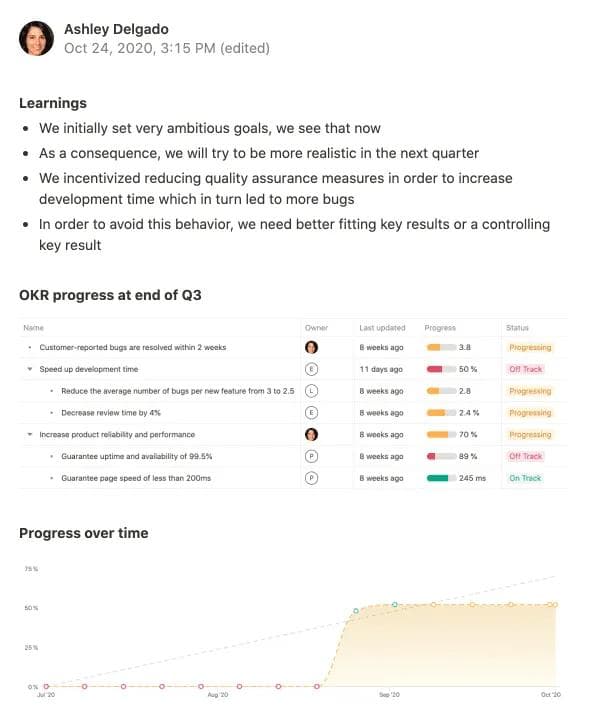
OKR Retrospective
The OKR Retrospective is the last event in the OKR cycle. While the OKR review reflects the content, i.e. the status of the OKRs, the OKR Retrospective reflects on a meta-level the OKR process or the OKR method itself and looks for improvement potential. In the retrospective, the agility of the OKR framework becomes clear: you start with framework parameters (length of the cycle, structure of check-ins, etc.) that you can adopt from this guideline, and adjust them until they are tailored to the individual needs of the organization.
The Start/Stop/Continue method provides a possible structure for the OKR retrospective:
- Start: What should we start with? (What can we improve?)
- Stop: What should we stop with? (What did not work?)
- Continue: What should we continue with? (What worked well?)
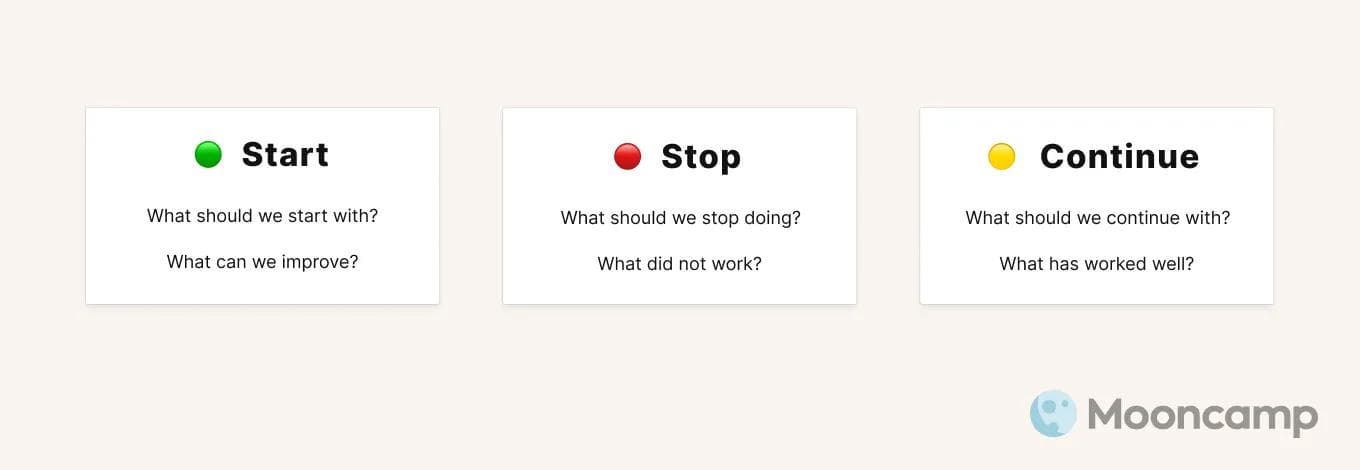
OKR coach (or OKR master)
The OKR coach, often also referred to as the OKR master, is responsible for the successful introduction and continuous support of the OKR method. The OKR coach takes on a number of central roles:
- Process owner: The coach leads the process, determines the initial framework parameters, moderates the individual events, and ensures that best practices are adhered to.
- Expert and mentor: The OKR coach is the "go-to-person" and advisory instance for all issues concerning the OKR method.
- Change agent: The introduction of OKRs is a change process. Every organizational change will meet resistance somewhere in the beginning. The OKR coach, therefore, has the task of involving all important stakeholders, especially the leadership.
In larger organizations, there are often multiple OKR coaches who introduce and support the OKR method. Especially for the first OKR cycle, it can be useful to take the first step with an external OKR consultant.
💡 Note: You do not need a full-time employee for the OKR coach role. The role usually requires an average of no more than four hours per week and can be shared by several employees to reduce the workload. Only at the very beginning will the workload be higher.
OKR tool
How important is it to use a tool for OKR management? Since Mooncamp itself offers a tool for OKR management and tracking, we are certainly biased here. But our experience with our customers shows that using Excel, Microsoft Planner or other free tools can quickly reach its limits, for example:
- Lack of overview and transparency
- Missing analytics capabilities
- Lack of collaboration features
If your organization should decide on a tool, we have put together a guide to choosing the best OKR software (at the end you can also download a Google sheet with customizable evaluation criteria to compare several OKR tools).
OKR consultancy
As already mentioned, working with an experienced OKR consultant can be particularly useful when introducing OKR in large companies. For example, it is easier to train the internal OKR coaches in advance, to create a holistic understanding of the OKR mindset and to incorporate expert experience so that typical rookie mistakes can be avoided. When choosing OKR consultants, it should be ensured that they are independent and concentrate on the successful introduction of OKR, rather than on selling software.
Frequently asked questions about the OKR method
Many of the following questions reach us again and again from our customers and prospects so that they might also be of interest to you:
Are Key Results with milestones instead of metrics allowed?
If possible, Key Results should always include relevant metrics that measure actual outcome, not just output. Projects with milestones belong to the output category so that they can be included as initiatives or tasks under the respective Key Results. For some Objectives it can be fairly difficult to come up with metric-based Key Results, so you might not have any other option than to include milestone-based Key Results. In general, however, this is not advisable.
Should individual OKRs be introduced at the employee level?
We recommend the exclusive use of the company and team OKRs. We generally advise against individual OKRs for two reasons: Firstly, personal OKRs lead to significantly more complexity, as the number of OKRs in the company increases three to tenfold, depending on the average team size. Second, there is the temptation to link individual OKRs to the employee's compensation, which would undermine the intrinsic motivation of the employees and the many benefits of the OKR method.
What is the difference between OKR and KPI?
KPI stands for Key Performance Indicator. An organization sets individual KPIs at the company or team level to measure specific outcomes (e.g., profit, turnover, or NPS). An OKR is a short-term goal that the organization considers important to ensure that KPIs are met and remain healthy. Most Key Results for OKRs should include a KPI (either directly or through a lead measure). Example: "Increase profit margin to 20%". Here profit margin is the KPI and the whole statement is the Key Result.
What is the difference between OKR and MBO?
MBO and OKR are both frameworks for goal management. MBO stands for "Management by Objectives". The OKR method has evolved from the MBO framework. These are the main differences:
- MBO defines what you want to achieve, while OKRs define the what and how
- MBO usually has annual reviews, while OKRs are evaluated every three to four months
- MBO targets are private and "in silos", while OKRs are public and transparent
- MBO is linked to compensation, while this should not be the case with OKRs
- MBO goals are rather conservative, while OKRs are ambitious
What is the best OKR software?
We have created an OKR Software Guide and an Excel template with 20 evaluation criteria to determine the best OKR tool for you. In the template, you can add your own evaluation criteria and adjust the weighting of the individual factors: OKR Software Guide.
Further Resources
OKR Rollout Guide
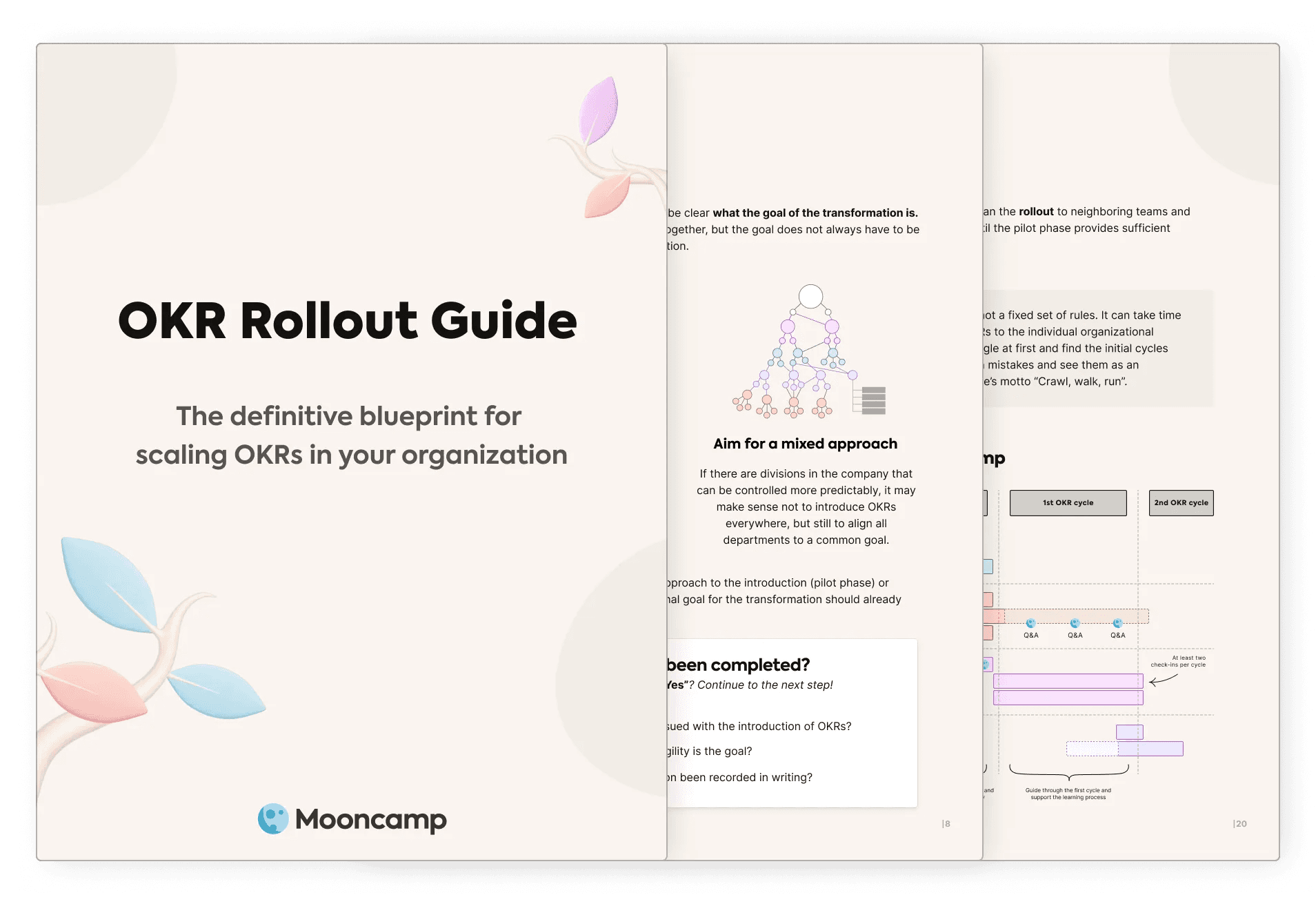
We have summarized the most important steps for the implementation of OKRs in our OKR rollout guide. You can download the guide as a PDF.
It contains experiences and best practices from successful OKR rollouts in hundreds of companies supported by our experts.
In our blog article "Introducing and scaling OKR: The complete rollout guide", we also provide an overview of the eight most important steps for a successful OKR rollout.
OKR Impact Report

If you want to know what the underlying ambitions are behind the introduction of OKRs, what an ideal OKR system looks like and what impact OKRs have on companies, you will find answers in our OKR impact report 2022. This is also available to download as a PDF.
Further OKR statistics as well as facts and figures on the impact of OKRs on companies can be found on our blog.
OKR PDF – Download the OKR method guide
With the following link, you can download this OKR-Guide as a PDF:
OKR Google video
The Google Video which in 2013 made the OKR framework famous "overnight". The video highlights the basics as well as how OKRs were handled by Google.
Please enjoy with caution: The video is already several years old and the examples shown do not always follow today's recognized best practices.
OKR books
These OKR books are a good introduction to the OKR method:
- Measure What Matters by John Doerr
- Radical Focus by Christina Wodtke

💡 Note: We have compiled a more comprehensive list of the best OKR books in our blog. They are intended as a basis to familiarize yourself with the OKR philosophy rather than as concrete instructions on how to implement OKRs. Still, the works by Doerr, Wodtke & Co. are definitely a good read to motivate yourself for OKRs and to learn from the "foster father of OKRs", among others.

